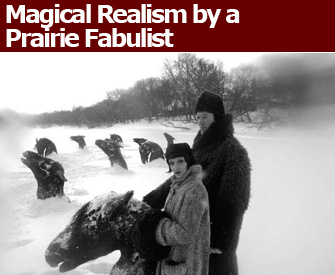
Film director Guy Maddin has been called “le David Lynch Canadien” by the French media. Like Lynch, Maddin mines the bizarre/bland dichotomy of a small town in his films. In Maddin’s case, it’s most often his hometown, the Canadian prairie city of Winnipeg.
His cinematic love/hate poem about the city, My Winnipeg (Winnipeg Mon Amour in French), a genre-defying docu-fantasy first released in 2007, opens today in France and was featured at the Centre Pompidou as part of a retrospective of his work, “Guy Maddin: Le Magicien de Winnipeg” (through November 7).
Maddin deliriously blends personal memories with invented, exaggerated and always surreal Winnipeg lore as he explores his relationship with his hometown. The outcome is sensory overload: part sleepwalking through the dreamscape of a city trapped in eternal winter, part psychosexual introspection and part emotionally charged existential rant, all humorously delivered.
Maddin shot My Winnipeg in his typical faux-documentary style, using 8mm film and video, which he blew up to look grainy and faded, as if it might be recently uncovered footage. He intersperses this with the occasional bit of real historical film, creating a style that gives quasi-credibility to his fantasia.
Still, audiences won’t know what to make of Maddin’s Winnipeg: They learn about “If Day,” a simulated Nazi invasion of the city during World War II; that Winnipeg has two cab companies – one whose turf is the city’s streets and the other its back lanes; and that one might encounter frozen horse heads sticking out of the Red River during a winter walk.
It’s magical realism done by a prairie fabulist, although some of the most implausible things mentioned in the film turn out to be true. Garbage Hill, for example, really does exist. Winnipeg’s lone ski slope, it is basically a mound of snow-covered garbage; when children slide down it, they risk being impaled on an old refrigerator or a moose antler. And the aforementioned If Day really happened: on February 19, 1942, five thousand government-hired actors simulated a Nazi takeover of Winnipeg in attempt to boost support for the Allied cause overseas.
When he is asked at film screenings what is real and what isn’t, as he is invariably is, Maddin’s reply is: “It’s all emotionally true.”
The movie is also an exploration of the psychological lockdown that keeps Maddin in Winnipeg. In the opening lines of the movie he chants with increasing desperation: “I must leave.” (This, too, is true to life. Maddin has often left Winnipeg, vowing never to return. He recently moved to Toronto, Canada’s largest city, to be near his daughter and her family, but was back within six months – something to do with there being no front stairs on his house.)
Wherever he is, though, Maddin inhabits his own cosmos.
In his other works, such as Tales From the Gimli Hospital, Cowards Bend the Knee, The Saddest Music in the World and Brand Upon the Brain! (all being screened at the Centre Pompidou), he also scavenges film history – in addition to his own feverish imagination, one can see the influence of neorealism, the expressionist films of the 1930s, French director Jean Vigo (Zero de Conduite was a favorite film of the young Maddin) as well as his Icelandic heritage and the huldufólk (invisible people who hide in the attic) that people its folklore.
In The Saddest Music in the World, Isabella Rossellini, his other muse (after Winnipeg), stars as Lady Port Huntly, a brewery heiress in a blond wig and tiara who has glass legs filled with her own beer. Maddin sets the film, shot mostly in grainy black and white, in Winnipeg in 1933, the fourth year in a row that a British newspaper has named the city “the world capital of sorrow.” Lady Port-Huntly devises a contest with a prize of $25,000 “in Depression-era dollars” to the performer of the saddest music. The result is a film like few others: gothic fantasy upended with slanted comedy.
Rossellini, daughter of the great Italian neorealist director Roberto Rossellini, is one of Maddin’s most fervent fans and has collaborated with him on other projects, notably 2006’s Brand Upon The Brain! (Des Trous dans la Tête! in French), another imaginary foray into a gothic Maddin childhood in the form of a silent science-fiction comedy set in a lighthouse on bleak Big Notch Island, where the protagonist, named Guy Maddin, is being raised by an iron-fisted, puritanical mother.
The movie was originally mounted as a theatrical event, accompanied by live orchestra, foley artists and narrators, including Rossellini, a role she reprised on October 20 at the Théâtre de l’Odéon in Paris.
Maddin has also been the subject of several documentaries, one by his friend and fellow Winnipeg director, Noam Gonick, which is also part of the retrospective.
When he presented My Winnipeg at the Berlin Film Festival in 2008, Maddin said “My dream is to show this film at the Berlin Film Festival and have hundreds of Germans watching it as a travelogue of Winnipeg.” Will Parisians see it the same way.
Favorite
